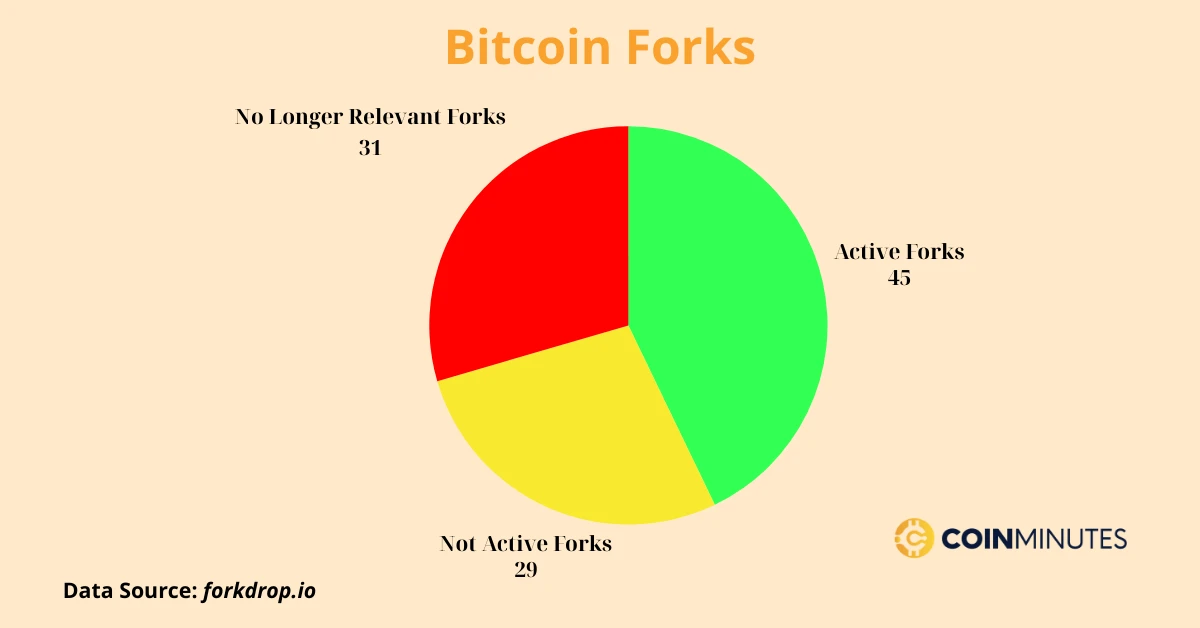Bitcoin forks can be revisions, upgrades, or even a different direction forked from the main Bitcoin network. These changes arise from Bitcoin’s limitations or disagreements about the network’s direction. This helps Bitcoin to become more perfect and to create better products than Bitcoin.
In this article, we will explore the concept of Bitcoin forks and discuss some of the most notable Bitcoin forks.
Key Takeaways
|
What Are Bitcoin Forks?
In blockchain, a fork is the process of changing the protocol or the core set of rules of the blockchain. Forks occur at a point where the software is copied and modified. When this happens, the blockchain splits and creates a new blockchain that shares the history of the original blockchain. However, the new blockchain will operate under different rules.
Forks can be intentional or accidental. Intentional forks are usually carried out to improve the blockchain or to add new features. Accidental forks can happen when there is a disagreement within the community about how the blockchain should operate.
When a fork occurs, the community decides which blockchain to continue using. For a hard fork, the blockchain with the most hash power typically becomes the dominant one. For a soft fork, both blockchains can continue to exist.
Since its launch in 2009, Bitcoin has undergone around 50 hard forks and many soft forks. Only a few forks remain active today, including Bitcoin (the original chain), Bitcoin Cash (BCH), Bitcoin SV (BSV), Bitcoin Gold (BTG), and Bitcoin Diamond (BCD). Most other Bitcoin forks have ceased to operate.

Forks can be a controversial topic within the blockchain community. Some believe that forks are a sign of a healthy and evolving ecosystem, while others think they can be disruptive and harmful.
Types of Bitcoin Forks
Soft Fork
A soft fork is a backward-compatible software upgrade for a blockchain. This means that older nodes can continue to participate in the network without updating their software, and updated nodes can still communicate with the older ones.
A soft fork usually involves adding a new rule that does not conflict with the old rules. Bitcoin’s first soft fork occurred on July 28, 2010, by disabling the OP_RETURN function, which allowed users to spend any Bitcoin on the network.
One of the most controversial soft forks in Bitcoin’s history was Segregated Witness (SegWit) in 2017. SegWit increased the block size limit. In this case, nodes that did not upgrade their software could still follow the old rules but could not participate in the new consensus rules.
Hard Fork
A hard fork is a software upgrade that is not backward-compatible with older versions of the blockchain. It requires all nodes to update their software to continue participating in the network. This means nodes running the new version of the blockchain will not recognize transactions from the old version, and vice versa.
During a hard fork, the blockchain splits into two separate versions: one that follows the new rules and one that follows the old rules.
For example, Bitcoin Cash, Bitcoin SV, and Bitcoin Gold are hard forks of Bitcoin. These forks were proposed to address scalability issues on the Bitcoin network, aiming for lower transaction fees and the ability to handle more transactions.
Pros and Cons of Bitcoin Forks
Pros
- Enhancing security: Forks can be used to address security vulnerabilities in blockchains. Example: The Bitcoin Cash fork aimed to increase the block size limit, which helps the blockchain withstand higher-level attacks.
- Launching new features: Forks can be used to add new features to blockchains. Example: The Ethereum Classic fork introduced a new feature called “replay protection,” preventing attackers from stealing funds between Ethereum and Ethereum Classic.
- Increasing decentralization: Forks help enhance the decentralization of blockchains by allowing the creation of new blockchains, which can be operated by different groups. Example: Bitcoin Cash was created and operated by a different group than the Bitcoin blockchain.
Cons
- Potential for confusion: Forks can lead to chain splits, causing confusion and disruption for users.
- Loss of funds: Forks can also result in loss of funds if users fail to upgrade their software to the new version of the blockchain. In 2017, some users did not upgrade their software after the Bitcoin Cash fork and consequently lost access to their funds on the Bitcoin Cash blockchain.
Notable Bitcoin Forks
SegWit
Segregated Witness (SegWit) is a proposed soft fork introduced by Pieter Wuille, a developer of Bitcoin Core, in late 2015 and activated on August 24, 2017. The objective of SegWit is to expand the block size on the network and store it in the Blockchain from 1 MB to 2 MB.
SegWit includes the following key changes:
- Separating signature data from transaction data: SegWit moves the signature data (witness data) out of the main part of the transaction data and places it into a separate structure. This reduces the size of each transaction, allowing more transactions to be included in each block.
- Addressing the transaction malleability issue: By separating the signature part, SegWit eliminates the possibility of altering transactions after they have been broadcast but not yet confirmed, improving the stability of transactions and paving the way for scalability solutions like the Lightning Network.
- Improving performance and scalability: With the new structure, the size of a block can exceed 1 MB, effectively allowing blocks to contain more transactions, reducing transaction fees, and increasing confirmation speeds.
Bitcoin Cash
Bitcoin Cash is a blockchain created through a hard fork of Bitcoin in August 2017 (from block 478558). At that time, Bitcoin holders received an equivalent amount of BCH for each BTC they held. Bitcoin Cash was created to become an improved version of Bitcoin, with better scalability and efficiency.
Bitcoin Cash came about due to debates within the Bitcoin community about the best way to address Bitcoin’s scalability issue. Some believed that increasing the block size was the best solution, while others advocated for layer-2 solutions like the Lightning Network. As a result, a group supporting block size increase decided to split off and create Bitcoin Cash.
Key features of Bitcoin Cash:
- Larger block size: One of the significant changes in Bitcoin Cash compared to Bitcoin is the increase in block size from 1MB to 8 MB. This allows for processing more transactions per block, reducing network congestion and lowering transaction fees.
- Faster transaction speeds: With a larger block size, Bitcoin Cash can confirm transactions faster and process more transactions per second (TPS) than Bitcoin.
- Scalability: Bitcoin Cash aims to become a global payment system with better scalability, capable of handling a large number of transactions equivalent to traditional payment networks like Visa or Mastercard.
- Compatibility with smart contracts and development protocols: Bitcoin Cash is also evolving to support smart contracts and dApps, although it’s still at a limited level compared to Ethereum.
Bitcoin Gold
Bitcoin Gold is a new digital currency formed after some developers conducted a Blockchain split – the underlying technology of Bitcoin. On October 24, 2017, just about 3 months after Bitcoin Cash was created, Bitcoin Gold came into existence.
Before Bitcoin Gold emerged, Bitcoin mining was mainly dominated by large companies with ASIC (Application-Specific Integrated Circuit) mining equipment. These devices were powerful and efficient, but they were expensive and inaccessible to small-scale miners, leading to a concentration of mining power in the hands of a few.
The goal of Bitcoin Gold is to decentralize mining by changing the mining algorithm, allowing regular users with GPU (Graphics Processing Unit) devices to participate efficiently.
Bitcoin Gold replaces Bitcoin’s SHA-256 algorithm with the Equihash algorithm. This allows those without specialized hardware to mine cryptocurrency easily. Instead of using high-speed mining machines, users can mine Bitcoin Gold with standard gaming graphics cards, similar to mining Ethereum. After the split, Bitcoin owners will receive an amount of Bitcoin Gold corresponding to their holdings, provided that their exchanges or digital wallets support the new currency.
Despite being the second major fork of Bitcoin, Bitcoin Gold did not receive much support from the mainstream market due to its technical sustainability issues. This currency is available for mining, but its price has not reflected significant community support yet.
The Bottom Line
Hard forks and soft forks are two critical elements for ensuring the sustainable success of blockchains. They provide anyone with the ability to implement changes and upgrades within the blockchain system without relying on third parties.








